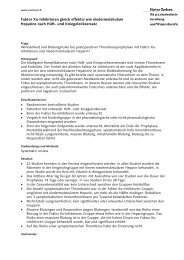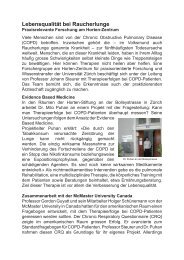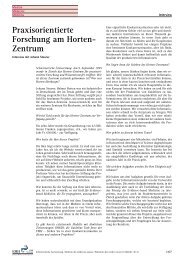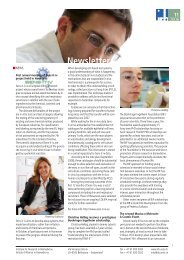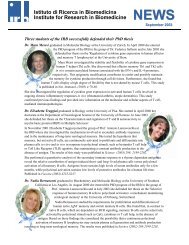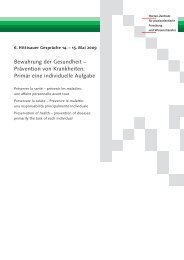Annals of Internal Medicine - Helmut Horten Stiftung
Annals of Internal Medicine - Helmut Horten Stiftung
Annals of Internal Medicine - Helmut Horten Stiftung
You also want an ePaper? Increase the reach of your titles
YUMPU automatically turns print PDFs into web optimized ePapers that Google loves.
Article Interval Exercise for Patients with Chronic Obstructive Pulmonary Disease<br />
Figure 1. Exercise protocols.<br />
sity exercise for 20 minutes, and a run-out phase <strong>of</strong> 2<br />
minutes (gradual decrease from 70% to 0%). If patients<br />
could not sustain the workload because <strong>of</strong> perceived dyspnea<br />
(modified Borg [26] ratings � 5 on a scale from 0 to<br />
10) or because heart rate exceeded safety limits, physical<br />
therapists let patients rest for 1 minute before continuing<br />
in the assigned phase. If patients had to rest more than<br />
twice per session, physical therapists lowered the workload<br />
by steps <strong>of</strong> 10% <strong>of</strong> baseline maximum exercise capacity for<br />
the following exercise sessions. If workload was too low<br />
(modified Borg ratings � 3 or patients or physical therapists<br />
considered the workload to be too low), physical therapists<br />
increased the workload by steps <strong>of</strong> 10% <strong>of</strong> baseline<br />
maximum exercise capacity.<br />
Interval Exercise<br />
The target workload for this group was 50% (highintensity<br />
intervals) and 10% (low-intensity intervals) <strong>of</strong><br />
short-term maximum exercise capacity as determined by a<br />
steep ramp test (27, 28). The steep ramp test is an incremental<br />
cycle ergometer test in which patients pedal cycle<br />
ergometers unloaded for 2 minutes and then at increments<br />
<strong>of</strong> 25 watts every 10 seconds until they cannot maintain a<br />
pedaling frequency above 50 pedals per minute or their<br />
heart rate exceeds the limit set by the normal incremental<br />
exercise test. We used the steep ramp test because workload<br />
for interval exercise can be underestimated if it is based on<br />
normal incremental exercise tests (28). Fifty percent <strong>of</strong><br />
short-term maximum exercise capacity corresponds, on average,<br />
to 90% to 100% <strong>of</strong> normal maximum exercise capacity<br />
(27). We chose a work–recovery ratio <strong>of</strong> 1:2 that<br />
prevents high lactate accumulation and is well tolerated by<br />
patients (28). In each session, patients had a warm-up<br />
period <strong>of</strong> 2 minutes at 10% <strong>of</strong> the short-term maximum<br />
exercise capacity and then exercised for 20 minutes alternating<br />
between high-intensity intervals for 20 seconds<br />
and low-intensity intervals for 40 seconds (Figure<br />
1). Patients also had a slowdown period <strong>of</strong> 2 minutes<br />
before completing the training session. We adjusted the<br />
exercise load for each patient individually if workload<br />
was too high or too low as described earlier; physiotherapists<br />
lowered or increased the workload by steps <strong>of</strong><br />
10% <strong>of</strong> short-term maximum exercise capacity, but the<br />
length <strong>of</strong> intervals remained constant (23).<br />
Outcomes and Measurements<br />
Our primary outcome for effectiveness was the difference<br />
from baseline in Chronic Respiratory Questionnaire<br />
(CRQ) scores 5 weeks after randomization as measured by<br />
the self-administered German-language version (29, 30)<br />
with standardized dyspnea questions (31). The CRQ is a<br />
widely used instrument in respiratory rehabilitation and<br />
measures dyspnea, fatigue, emotional functioning, and<br />
ability to cope with COPD (7, 32). Domain and total<br />
(average <strong>of</strong> domains) scores are presented on a Likert-type<br />
scale from 1 (most severe impairment) to 7 (no impairment).<br />
We selected assessment at 5 weeks after randomization<br />
as the primary outcome for the CRQ because the<br />
recall period is 2 weeks, and its questions concern impairment<br />
associated with activities <strong>of</strong> daily living in the home<br />
environment.<br />
Patients also completed the self-administered Germanlanguage<br />
version <strong>of</strong> the Hospital Anxiety Depression Scale,<br />
with depression and anxiety domain scores from 0 (no<br />
depression or anxiety) to 21 (most severe symptoms <strong>of</strong><br />
depression or anxiety) (33). In addition, they rated their<br />
health state on the feeling thermometer (34), a validated<br />
preference-based instrument with marked intervals from 0<br />
(worst health state equals dead) to 100 (perfect health).<br />
The feeling thermometer is increasingly being used as a<br />
global estimate <strong>of</strong> the effect <strong>of</strong> interventions, including respiratory<br />
rehabilitation (35, 36).<br />
We used 3 exercise tests to measure changes <strong>of</strong> exercise<br />
capacity. Six-minute walking distance was measured twice<br />
at the beginning and once at the end <strong>of</strong> the inpatient rehabilitation<br />
according to established criteria (37). We used<br />
the best <strong>of</strong> the first 2 six-minute walking distances as the<br />
baseline value. Patients completed the steep ramp test and<br />
an incremental cycle ergometer test to measure anaerobic<br />
and aerobic exercise capacity, respectively (23). Physicians<br />
from the respiratory medicine unit and physiotherapists<br />
from other units <strong>of</strong> the hospital who supervised these exercise<br />
tests were not involved in the supervision <strong>of</strong> exercise<br />
sessions and therefore were blinded to group assignment.<br />
Our primary outcome for tolerance <strong>of</strong> exercise protocols<br />
was the number <strong>of</strong> unintended breaks lasting 1 or<br />
more minutes during the inpatient rehabilitation, which<br />
were recorded by physiotherapists on the clinic’s routine<br />
818 5 December 2006 <strong>Annals</strong> <strong>of</strong> <strong>Internal</strong> <strong>Medicine</strong> Volume 145 Number 11 www.annals.org



